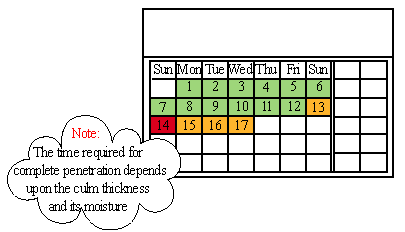Vertical Soak Diffussion for Bamboo Conservation

Environmental
Bamboo Foundation
This excellent document is converted from a PDF document
from the www.bamboocentral.org
website.
This was done due to the
PDF causing my PC to hang and space issues. For the complete and exceptional PDF document please visit there website. No information has been altered. The Environmental Bamboo Foundation (EBF) is an Indonesian non-profit organization started in 1993 by designer and environmentalist, LINDA GARLAND.
The EBF strives to protect tropical forests by promoting and demonstrating the many conservation and development opportunities that bamboo offers. The mission of the Environmental Bamboo Foundation is to encourage, through research and education, the sustainable planting and utilization of bamboo in an effort to promote its many environmental benefits and protect the world’s remaining tropical forests and mangroves.
Based in Bali, Indonesia, the EBF has affiliate non-profit organizations in the United States and in Holland.
Acknowledgements
Initial research on modified Boucherie Teatment was done by Prof. Dr. W. Liese, Universität Hamburg, Germany, and later adapted by the Environmental Bamboo Foundation with Don Longuevan under a grant from IESC International Executives Service Corp. Laboratory testing was performed by Koppers-Hickson in New Zealand.
We thank Ben Brown of Mangrove Action Project for providing valuable help and insight during the testing period and providing translation services for the Indonesian edition.
We appreciate the advise/comments made by Prof.Liese along the development of the VSD treatment.
Many thanks to Emerald Starr of Sacred Mountain Sanctuary in Sideman, Bali, who used a high percentage of experimental VSD treated bamboo timbers when building his resort. Seven years later, the bamboo he used is still in excellent condition.
| Research & Development: |
Environmental Bamboo Foundation (EBF) |
| Graphics & Layout: | Studio LaBel, Hedi LaBel |
| Engineering Consultant: |
Ben Brown |
| Editorial Assistant: | Petra Schneider |
| Project Manager: | Ketut Sadia |
This publication is not copyrighted. EBF encourages the translation, adaptation and copying of materials for non-commercial use, providing an acknowledgement to EBF.
Every effort has been made to ensure that all the information in this booklet is accurate. However, due to differing conditions, kind and age of the bamboos, tools, and individual skills, the publisher cannot be responsible for any injuries, losses, and other damages that may result from the use of the information of this booklet.
First Edition published 2-1-2003 by: LINDA GARLAND Environmental Bamboo Foundation, Bali, Indonesia, ebf@bamboocentral.info, www.bamboocentral.org
Table of Contents
1. Preface
2. Introduction
5. Planning a Treatment Center
5.1 Elevation View
5.2 Floor Pan
8.1 Reuse Guidelines
8.3 Where to buy BORATES in Indonesia
Preface
The use of bamboo products requires often its protection against biodegradation by chemical treatment. Its application is hindered by the structure of the culm, the need for larger technical installations and the danger of environmental side-effects. The VSD method developed by EBF is obviously an efficient method to obtain well treated culms, safe to be handled. Its wider application, also to other species, will strengthen its base.
Walter Liese Universität Hamburg, Germany
Bamboo culms are a natural material susceptible to insect and fungal attack. Without treatment products made from bamboo can be expected to last for only up to 3 years. There are many different techniques for curing and treating bamboo culms in order to prevent splitting, insect infection and fungal growth.
In this booklet we present the Vertical Soak Diffusion (VSD) method which uses minimally toxic borates as preservatives. The method has been tested in Indonesia using three species of bamboo: Dendrocalamus asper* Gigantochloa apus* Gigantochloa atter* If you are intending to use other species of bamboo, follow the methodology in this booklet to treat a small section (1-2 internodes) and observe the rate of penetration of the red dye discussed in step 14, page 18
Whereas bamboo treated by the modified boucherie system (a pressure system introduced by Prof. Dr. Liese, Hamburg, Germany) is appropriate for large scale plantations growing bamboo for construction timber, furniture, and some crafts the VSD system works well with small-plantation situations , and community development work in rural villages.
Managing Bamboo
| Clumping bamboos are non-
invasive. They do not ruin buildings, they grow very fast when young and the culms are larger than those of the running bamboo. They require little maintenance, although simple clump management will benefit both the grower and the bamboos. |
 |
| In the dry season, almost all culms that are 3 years or older can be removed from a clump by cutting them just above a node about 20cm above the ground. Some younger ones have to remain for further nourishment of the rhizome. |
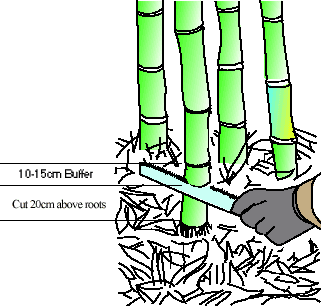 |
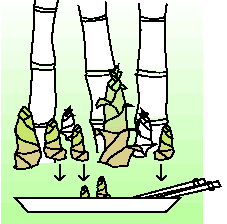 |
In any shoots that are going overcrowding (many edible, cooked). Leave shoots of good diameter have potential to produce strong poles for timber
|
Harvesting Bamboo

Dry Season
 |
| Wet Season |
Harvest Bamboo during dry season
The best season for harvesting is after the rainy season when starch content in the bamboo sap is low. Starch is the favourite food for pests. Don’t harvest during shooting season! Cut bamboo that is 3-5 years old. Bamboo older than 5 years is harder and the inner culm wall becomes impermeable to the BORAX BORIC ACID Solution.
|
There are 2 different ways to tell the age of bamboo culms: 1) Mostly, culms at the inside of a clump are the oldest. 2) Label the new shoots, this is the safest method. |

| The culms should be treated soon after having been cut, but can be left for a few days standing upright, placed on a stone. Due to the ongoing transpiration by the leaves the culm will loose some of its moisture and also starch, which is the food for the pest, i.e. the Powderpost Beetle. But don’t wait too long, since moisture is required for the following diffusion process. |
 |
The Powderpost Beetle
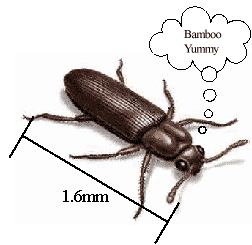
Stored bamboo is endangered by beetle infestation which can be recognized in the form of a talcum-like powder and small holes in the area of the nodes and along the internodes.
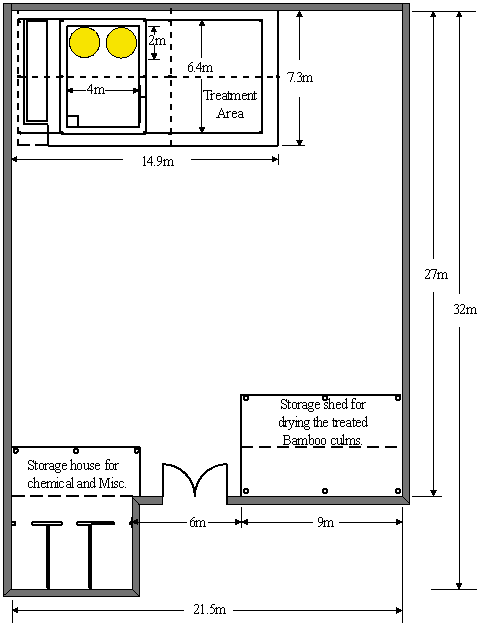
Floor
Pan
Elevation View

Floor plan Treatment Area
Tools and Materials
Eye Protection

Hacksaw![]()
Rubber Gloves![]()
Iron Rod with hex Nut ![]()
Rubber Boots
Bamboo Stick for Stirring![]()
Boric Acid
Pump
Plastic Containers Mixing & Measuring
Small Sum pump![]()
Red Textile Dye Aniline![]()
Rubber Hose![]()
Water
Node Punch
Filter 
Hydrometer ![]()
Containers For Solution
Brushes for cleaning ![]()
Rope (for tying culms) 
Mixing the Borax Solution
|
STEP 1 Calculate There are 3 differrent ways to do this: 1. Volume in liters = inner radius squared x 3.1416 x height in Example: bamboo with radius = 6cm, height ((6×6) 2. Fill one punctured culm with water and simply measure how many liters it takes to fill it up. Multiply by the number of culms. 3. Fill one average internode; measure the amount in liters and multiply by the number internodes and by the number of culms.
|
|
STEP 2 Mix gives a 9 to 1 or 10% Borax 3kg Water 45 litres 1.5 litres each |
| STEP 3 |
Add red analyn textile dye. It should completely penetrate the tissue of the culms from the inside all the way to the outside skin. If the particles of the dye are too large they will only partially dissolve and “plug” the openings in the tissue thus preventing penetration of the preservative.
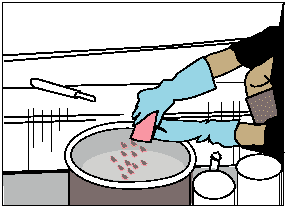
| STEP 4 |
Slowly add water stirring constantly until BORAX/BORIC ACID and dye are completely dissolved and no more crystals are at bottom of container.
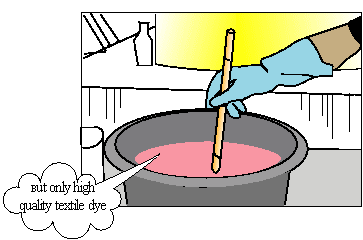
| STEP 5
Test
Fill a small test container with This Then |
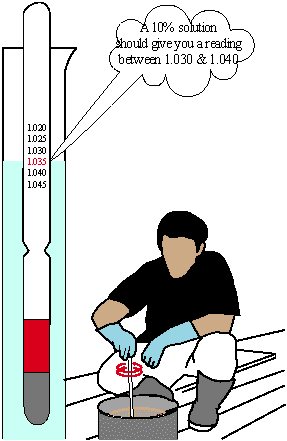
| STEP 6
|
| Thoroughly clean the outside of the bamboo culms with water and and sand, or scotch brite) |
| STEP 7
Weld hex nut The |
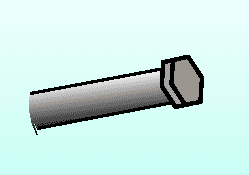 |
|
Place wall. Insert the iron rod punch holes through the |
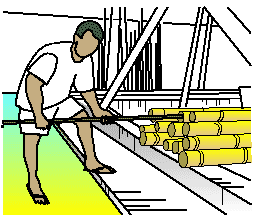 |
| STEP 9
Move the bamboo to the concrete basin. |
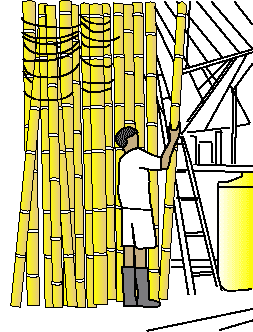 |
| STEP 10 |
Connect a hose to the container which holds the mixture. Pump the solution into the culms.
STEP 11
Fill the entire bamboo with the solution. Every morning refill the culms which have absorbed approximately 1% of the liquid overnight. Every day absorption rate is less.

| STEP 12
|
| On Day 13 don’t add more solution. |
Allow the level to go down to avoid overflow when the last node is broken.
| STEP 13
On Day 14, test check the culm by sawing off the upper internode. The
|
 |
| STEP 14 Leave the |
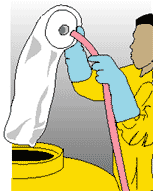 |
| STEP 15 |
Store the bamboo
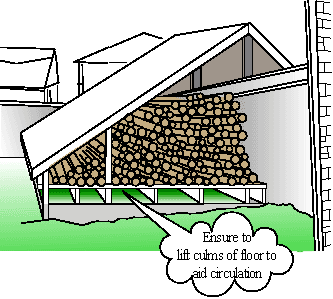
Information
about Borates
| BORAX/BORIC ACID is more environmentally friendly than other wood preservatives currently used. Reuse Guidelines |
The BORAX/BORIC ACID SOLUTION can be used more than once for treating bamboo, as long as the hydrometer reading of the solution is still at the initial level, of approximately 1.035.
Keep in mind that, as the bamboo sap gets partially drained out of the culm, the starch/sugar from the sap will move into the treatment solution. This can lead to inaccurate hydrometer readings. After the 3rd or 4th use gradually increase the BORAX/BORIC ACID concentration to 1.040 and 1.050.
At the point when the drained solution foams significantly and/or mold is forming on the surface of the solution and on the bamboo culm it is time for the solution to be disposed of.
Disposal Guidelines
BORAX/BORIC ACID is non toxic to the environment, but is highly
saline. When a moderate amount of it is absorbed into the ground, the ground filters out the salt to the point where it does not pollute the ground water. However, it is advisable to dispose of it safely and out of reach of children. When diluted with more water the discarded solution could be used as a herbicide on terraces and walkways.
Where
to buy BORATES in Indonesia
PT CHIMIFIN JAYA UTAMA, JAKARTA
Tel 021-424-0202, 424-7141, 425-5563
Fax 420-5588
UD. Saba Kimia, Denpasar,
Tel/Fax 0361-410662




